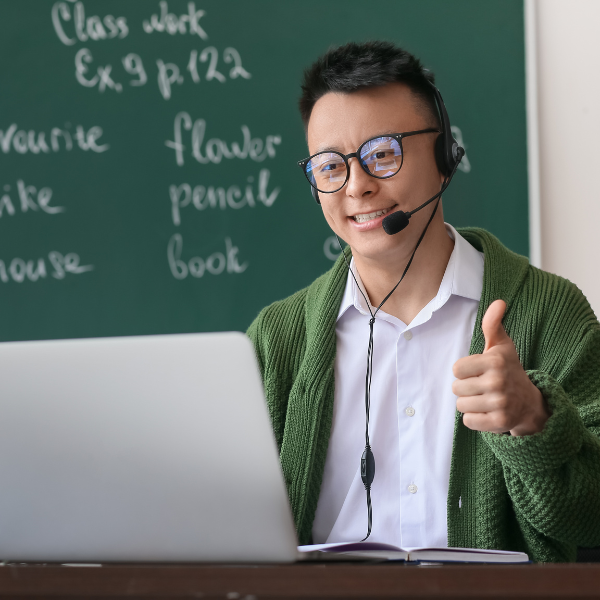
Teachers have a history of being underappreciated and overworked. Teaching in and beyond the pandemic has been particularly thankless and unsustainable, as schools respond to the unfinished learning needs of their kids while curricula became a political football. Teacher job satisfaction hit an all-time low last year. Unsurprisingly, teachers flocked to virtual schools during the pandemic due to their relative safety and flexible nature, a shift that aligns with the broader societal movement towards more flexible remote work environments. But the disconnected, unstable nature of virtual learning is creating a teacher morale problem unique to virtual schools.
The Learning Accelerator’s work supporting 20 school systems with virtual or hybrid programs around the country as part of our Strategy Lab networked learning experience has revealed the novel morale challenges facing teachers in virtual and hybrid learning environments. Unlike brick-and-mortar schools, virtual and hybrid programs lack the default informal interactions with teachers’ colleagues, students, and students’ families – it’s difficult to pull a student aside, debrief with a colleague in the break room, or check-in at the carpool line when you’re miles apart. Instead, virtual teachers often face a class of students hidden behind black boxes on a computer screen. Furthermore, virtual and hybrid programs are often confused for temporary learning environments or COVID-like remote learning that lack quality and rigor.
The flip side of flexibility is that it can create instability for virtual and hybrid programs that further adds to the challenge as volatile enrollment shifts – with students moving in and out of programs more frequently, including some that are in the system temporarily – and leadership changes cause programs to shrink and teachers to be redeployed to brick-and-mortar schools, making the virtual teaching role unpredictable. More than one-quarter of virtual programs in our Strategy Lab expressed concern about the sustainability of teaching within their program, while two-thirds spoke to program instability. In order for virtual and hybrid programs to be sustainable, school systems must consider two key factors in how they design their programs: facilitating human connection and establishing clear expectations.
Designing Virtual Programs for Human Connection
Schools are inherently designed for human connection. Bringing pupils and teachers together under one roof lends itself to deep relationship building, a key factor in quality learning environments. As highlighted in our research on the design factors for quality remote learning, creating systems to develop and deepen relationships between teachers and students is critical. Unfortunately, it’s easy to fall short in designing a program to ensure quality relationships are built with students: many virtual programs struggle to ensure students are successful in accessing and attending virtual learning. A lack of guidance and purposeful classroom community development can lead some students to feel uncomfortable turning on their video screen, leaving teachers instructing a screen of black Zoom squares. Most of the Strategy Lab cohort identified a lack of relationships as a significant factor contributing to engagement challenges: 14 of 20 teams took on improvement efforts that impacted relationships in their virtual and hybrid programs.
Strategy Lab teams have demonstrated the potential of designing virtual and hybrid programs for greater human connection. The Northeastern Regional Information Center (NERIC) team, whose virtual program serves 400 students across 142 schools in their region of New York, identified an opportunity to improve their student onboarding process to emphasize relationships. Instead of leading with academics, they shifted to emphasizing relationship building first across their network before teaching content. New students enrolling mid-year are given scaffolded support to enter their virtual class community. The NERIC team wasn’t alone in exploring this challenge, though. A number of teams, including KIPP DC (DC), Matrix for Success Academy (CA), and Newport News Public Schools (VA), have also piloted mentoring and advisory programs to better meet student needs, with initial pilot feedback showing both teachers and students seeing positive benefits. For example, all five of Newport News’ pilot teachers recommended continuing their mentorship program, while 97% of KIPP DC students reported that their experience in their virtual program improved when a teacher or staff member checked in with them as part of their pilot. Additionally, our adult wellbeing research sheds light on sustainable, long-term strategies for supporting adults in schools broadly.
Building a Foundation with Clear Expectations & Common Norms
Virtual learning environments rely heavily on independent, self-direction from students. The lack of physical proximity found in traditional brick-and-mortar learning environments requires students to exert additional effort to engage. Additionally, student success in virtual programs can rely heavily on their personal networks at home, as caregiver engagement has been shown to increase outcomes. For teachers, keeping students on task is even more challenging, as classic engagement strategies like tapping a shoulder or talking privately with a student while in ear-shot of others just aren’t possible. Supporting teachers – and setting all students up to succeed, not just those with additional at-home support – requires leaders to thoughtfully design clear expectations and norms that align with their context. In our Strategy Lab cohort, half of the teams shared challenges with and the need to set consistent norms and expectations across classes – for students, families, and teachers.
Initial data from revised team assessments indicate that many Strategy Lab teams worked to improve the clarity and consistency of their expectations over the past year. For NERIC and a handful of other teams, effective professional development became an important vehicle for establishing norms and expectations, including encouraging students to be active in live sessions and creating routines that support relationship building. Another key lever for nearly half of the cohort was communication. Many teams prioritized family and student communication in their pilots, critically evaluating how information was shared and anticipating where confusion or problems may arise. Others focused on improving the messaging about their program, citing common misunderstandings from families around the vision for learning and the program’s intent.
Virtual teaching has a unique morale problem, but it is solvable. While these are desirable roles in school districts, the flexibility of teaching in virtual schools has created new challenges, especially with connecting to colleagues and students, as well as program stability. Rather than reinvent the wheel, leaders can lean on existing research and strategies to prioritize designing for human connection and establishing clear expectations to make virtual teaching more sustainable. Additionally, leaders should seek to provide as much stability and support as possible, treating virtual schools as they would a brick-and-mortar school with a long-term, predictable commitment to programming and staffing. In doing so, virtual teaching can achieve its potential as a flexible, valued experience for teachers as well as their students and students’ families.
For more, explore TLA’s Virtual School Profiles and Problem-of-Practice series on virtual, remote, and hybrid learning.

